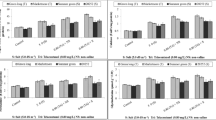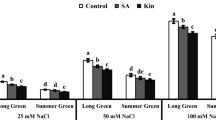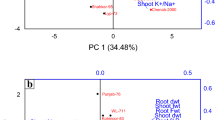Abstract
A pot experiment with 17 diverse genotypes of cucumber with four levels of salt stress viz., 0, 2, 4 and 6 dS m−1 was carried out during 2006. ANOVA revealed significant differences amongst genotypes and genotype × salt stress interaction indicating the genetic variability and differential response of the genotypes to different salt stress levels. The salt stress adversely affected the biochemical parameters; effects were severe under 4 dS m−1. No genotype could survive at 6 dS m−1. Sodium content, Na+–K+ ratio, proline, reducing sugars, phenol and yield reduction (%) increased significantly as the salt stress increased. Potassium, chlorophyll, membrane stability index and fruit yield decreased significantly under salt stress in all genotypes. However, the genotypes CRC-8, CHC-2 and G-338 showed lower accumulation of sodium, lesser depletion of potassium, lower Na+–K+ ratio and higher accumulation of proline, reducing sugars, phenols, better membrane stability and lower yield reduction (%) under salt stress, while CH-20 and DC-1 were sensitive to salt stress. Thus, a combination of traits such as higher membrane stability, lower Na+–K+ ratio, higher osmotic concentration and selective uptake of useful ions and prevention of over accumulation of toxic ions contribute to salt stress tolerance in cucumber. These traits would be useful selection criteria during salt stress breeding in cucumber.


Similar content being viewed by others
References
Agong SG, Kingestsu M, Yoshida Y, Yazawa S, Masuda M (2003) Response of tomato genotypes to induced salt stress. Afr Crop Sci J 11:133–142
Ashraf M, McNeilly T (1988) Variability in salt tolerance of nine spring wheat cultivars. J Agron Crop Sci 160:14–21
Ashraf M, O’Leary JW (1996) Responses of some newly developed salt-tolerant genotypes of spring wheat to salt stress. 1. Yield components and ion distribution. J Agron Crop Sci 176:91–101
Bailly C, Benamar A, Corbineau F, Cone D (1996) Changes in malondialdehyde content and in superoxide dismutase, catalase and glutathione reductase activities in sunflower seeds as related to deterioration during accelerated aging. Physiol Plant 97:104–110
Barnes JD, Balaguer L, Manrigue E, Elivira S, Davison AW (1992) A reappraisal of the use of DMSO for the extraction of chlorophyll a and b in lichens and higher plants. Environ Exp Bot 32:85–90
Bates LS, Waldron RP, Teare ID (1973) Rapid determination of free proline in water stress studies. Plant Soil 29:205
Bhattacharjee S, Mukherjee AK (1996) Ethylene evolution and membrane lipid peroxidation as indicators of salt injury in leaf tissues of Amaranthus seedlings. Indian J Exp Biol 34:279–281
Bohnert HJ, Jensen RG (1996) Strategies for engineering water stress tolerance in plants. Trends Biotechnol 14:89–97
Botia P, Navarro JM, Cerda A, Martinez V (2005) Yield and fruit quality of two melon cultivars irrigated with saline water at different stage of development. Eur J Agron 23:243–253
Bray EA, Bailey-Serres J, Weretilnyk E (2000) Responses to abiotic stresses. In: Buchanan BB, Gruissem W, Jones RL (eds) Biochemistry and molecular biology of plants. ASPP, Rockville, pp 1158–1203
Bustan A, Cohen S, De-Malach Y, Zimmermann P, Golan R, Sagi M, Pasternak D (2005) Effect of timing and duration of brackish irrigation water on fruit yield and quality of late summer melons. Agric Water Manage 74:123–134
Cruz V, Cuartero J, Bolarin MC, Ramero M (1990) Evaluation of characters for ascertaining salt stress responses in Lycopersicon species. J Am Soc Hortic Sci 115:1000–1003
Dionisio-Sese ML, Tobita S (1998) Antioxidant responses of rice seedlings to salinity stress. Plant Sci Limerick 135:1–9
Dubey SK, Maurya IZ (2003) Studies on heterosis and combining ability in bottle gourd. Indian J Genet Plant Breed 63:148–152
El-Hendawy SE, Hu Y, Schmidhalter U (2005) Growth, ion content, gas exchange, and water relations of wheat genotypes differing in salt tolerances. Aust J Agric Res 56:123–134
Gadallah MAA (1999) Effect of proline and glycine-betaine on Vicia faba in response to salt stress. Biol Plant 42:247–249
Ghoulam C, Foursy A, Fares K (2002) Effects of salt stress on growth, inorganic ions and proline accumulation in relation to osmotic adjustment in five sugar beet cultivars. Environ Exp Bot 47:39–50
Gomez KA, Gomez AA (1984) Statistical procedures for agricultural research. Wiley, New York
Greenway H, Munns H (1980) Mechanisms of salt tolerance in nonhalophytes. Annu Rev Plant Physiol 31:149–190
Hong ZL, Lakkineni K, Zhang ZM, Verma DPS (2000) Removal of feedback inhibition of delta (1)-pyrroline-5-carboxylate synthetase results in increased proline accumulation and protection of plants from osmotic stress. Plant Physiol 122:1129–1136
Kaya C, Higgs D, Ince F, Amador BM, Cakir A, Sakar E (2003) Ameliorative effects of potassium phosphate on salt stressed pepper and cucumber. J Plant Nutr 26:807–820
Kupier PJC (1984) Functioning of plant cell membranes under saline conditions: membrane lipid composition and ATPase. In: Staples RC, Toenniessen GH (eds) Salinity tolerance in plants—strategies for crop improvement. Wiley, New York, pp 77–91
Levine RL, Garland D, Oliver C, Amici A, Clement I, Lenz AG, Ahn BW, Shalteil S, Stadtman ER (1990) Determination of carboxyl content in oxidatively modified proteins. Methods Enzymol 186:464–478
Martinez V, Nunez JM, Ortiz A, Cerda A (1994) Change in amino acid and organic acid composition in tomato and cucumber plants in relation to salinity and nitrogen nutrition. J Plant Nutr 17:1359–1368
Munns R (2005) Genes and salt tolerance: bringing them together. New Phytol 167:645–663
Munns R, Tester M (2008) Mechanisms of salinity tolerance. Annu Rev Plant Biol 59:651–681
Munns R, Hare RA, James RA, Rebetzke GJ (2000) Genetic variation for improving the salt tolerance of durum wheat. Aust J Agric Res 51:69–74
Munns R, James RA, Läuchli A (2006) Approaches to increasing the salt tolerance of wheat and other cereals. J Exp Bot 57:1025–1043
Nanjo T, Kobayashi M, Yoshiba Y, Sanada Y, Wada K, Tsukaya H, Kakubari Y, Yamaguchi-Shinozaki K, Shinozaki K (1999) Biological functions of proline in morphogenesis and osmotolerance revealed in antisense transgenic Arabidopsis thaliana. Plant J 18:185–193
Nuccio ML, Rhodes D, McNeil SD, Hanson AD (1999) Metabolic engineering of plants for osmotic stress resistance. Curr Opin Plant Biol 2:128–134
Pasternak D (1987) Salt tolerance and crop production: a comprehensive approach. Annu Rev Phytopathol 25:271–291
Richards RA (1993) Should selection for yield in saline regions be made on saline or non-saline soils? Euphytica 32:431–438
Royo A, Aragüés R (1999) Salinity-yield response functions of barley genotypes assessed with a triple line source sprinkler system. Plant Soil 209:9–20
Royo A, Aragüés R, Playán E, Ortiz R (2000) Salinity-grain yield response functions of barley cultivars assessed with a drip injection irrigation system. Soil Sci Soc Am J 64:359–365
Sairam RK, Tyagi A (2004) Physiology and molecular biology of salinity stress tolerance in plants. Curr Sci 86:407–421
Shannon MC (1997) Adaptation of plants to salinity. Adv Agron 60:75–120
Shaterian J, Waterer D, Jong HD, Tanino KK (2005) Differential stress responses to NaCl salt application in early and late-maturing diploid potato (Solanum sp.) clones. Environ Exp Bot 54:202–212
Shiqing S, Shirong G, Qingmao S, Zhigang Z (2006) Physiological effects of exogenous salicylic acid on cucumber seedling under salt stress. Acta Hortic Sin 33:68–72
Singh AK (2004) The physiology of salt tolerance in four genotypes of chickpea during germination. J Agric Sci Technol 6:87–93
Smirnoff N, Cumbes QJ (1989) Hydroxyl radical scavenging activity of compatible solutes. Phytochemistry 28:1057–1060
Stepien P, Kobus S (2005) Water relations and photosynthesis in Cucumis sativus L. leaves under salt stress. Biol Plant 50:610–616
Steppuhn H, van Genuchten MT, Grieve CM (2005) Root-zone salinity. I. Selecting a product-yield index and response functions for crop tolerance. Crop Sci 45:209–220
Tarczynski MC, Jensen RG, Bohnert HJ (1992) Expression of a bacterial mtlD gene in transgenic tobacco leads to production and accumulation of mannitol. Science 259:508–510
Tester M, Davenport RJ (2003) Na+ transport and Na+ tolerance in higher plants. Ann Bot 91:503–527
Thimmaiah SK (1999) Standard methods of biochemical analysis. Kalyani Publishers, Ludhiana, p 545
Trajkava F, Papadantonakis N, Savvas D (2006) Comparative effect of NaCl and CaCl2 on cucumber grown in a closed hydroponics system. HortScience 41:437–441
Turner NC, Nicolas ME (1987) Drought resistance of wheat for light-textured climate. In: Srivastava JP, Proceddu E, Acevedo E, Varma S (eds) Drought tolerance in winter cereals. Wiley, New York, pp 203–216
US Salinity Laboratory Staff (1954) Diagnosis and improvement of saline and alkali soils. US Department Agriculture Handbook No 60, USSL, Riverside
Villa-Castorena M, Ulery AL, Valencia EAC, Remmenga MD (2003) Division S-4-soil fertility and plant nutrition. Soil Sci Soc Am J 67:1781–1789
Villora G, Pulgar G, Moreno DA, Romero L (1998) Plant nitrogen characteristics of a semi-salt tolerant Zucchini variety to sodium chloride treatments. J Plant Nutr 21:2343–2355
Welbaum GE, Bradford KJ (1990) Water relation of seed development and germination in muskmelon (Cucumis melo L.). Am Soc Plant Physiol 92:1038–1045
Yeo AR, Flowers TJ (1986) Salinity resistance in rice (Oryza sativa L.) and a pyramiding approach to breeding varieties for saline soils. Aust J Plant Physiol 13:161–173
Zeng L, Shannon MC, Grieve CM (2002) Evaluation of salt tolerance in rice genotypes by multiple agronomic parameters. Euphytica 127:235–245
Zeng L, Poss JA, Wilson C, Draz A, Gregorio GB, Grieve CM (2003) Evaluation of salt tolerance in rice genotypes by physiological characters. Euphytica 129:281–292
Zhu JK (2002) Salt and drought signal transduction in plants. Annu Rev Plant Biol 53:247–273
Zhu GY, Kinet JM, Lutts S (2001) Characterisation of rice (Oryza sativa L.) F-3 populations selected for salt resistance I. physiological behaviour during vegetative growth. Euphytica 121:251–263
Acknowledgments
Jagesh K. Tiwari thanks Indian Agricultural Research Institute, Pusa, New Delhi for providing senior research fellowship to conduct this study.
Author information
Authors and Affiliations
Corresponding author
Additional information
Communicated by A. Aniol.
Rights and permissions
About this article
Cite this article
Tiwari, J.K., Munshi, A.D., Kumar, R. et al. Effect of salt stress on cucumber: Na+–K+ ratio, osmolyte concentration, phenols and chlorophyll content. Acta Physiol Plant 32, 103–114 (2010). https://doi.org/10.1007/s11738-009-0385-1
Received:
Revised:
Accepted:
Published:
Issue Date:
DOI: https://doi.org/10.1007/s11738-009-0385-1




